I am sharing my personal opinion in this essay. I have, however, hijacked the use of a presentation designed to encourage increased support for public funding for the arts in Wisconsin and am using it toward my own ends.
“If we are seeking in America, let it be for the reality of democracy in the arts. Let art begin at home and let it spread through the children and the parents, and through the schools and the institutions, and through government. And let us start by acceptance, not negation-acceptance that the arts are important everywhere, and that they can exist and flourish in small places as well as large, with money or without it, according to the will of the people. Let us put firmly and permanently aside the cliche that the arts are a frill. Let us accept the goodness of art where we are now, and expand its worth in the places where people live.” Robert E. Gard, Professor Emeritus of Community Theatre, University of Wisconsin
Wisconsin is in the middle of a huge public engagement defining the future of our State. Hundreds of thousands of citizens have been demonstrating at our Capitol and across the State to make their opinions known regarding the fiscal and non-fiscal matters covered in the Governor’s proposed budget and budget repair bill. Mixed in among many other issues and cuts in the budget bills are cuts which will essentially end 35 years of Wisconsin Arts Board service to the State of Wisconsin.
I’ve been proud of the creative and peaceful protests that have taken place in Wisconsin over the last few weeks in reaction to Governor Walker’s proposed budget and budget repair bill. I have been proud of the citizens exercising their freedom of speech, and of the way law enforcement has handled their work (the police largely support the protesters rallying to demand a more measured and thoughtful approach to dealing with our States economic challenges). Artists and creative spirits have been scattered among those protesting. SolidARTity is an art exhibition in Madison that is currently presenting the breadth of creative expression that’s emerged during the political protests in Madison in recent days. The major advocacy organization for arts and artists in the state Arts Wisconsin, has had a presence as well carrying the message of the importance of the arts to Wisconsin to the legislature and the State.
Last Tuesday night, March 4th, 2011 I went to speak to a new art organization in a town of almost 800 people about an hour from Madison. I went as a volunteer citizen member of the Wisconsin Arts Board (WAB) to share the kinds of support the budding group might hope to receive from their state arts board. The Wisconsin Arts Board is the state agency which nurtures creativity, cultivates expression, promotes the arts, supports the arts in education, stimulates community and economic development and serves as a resource for people of every culture and heritage.
I have served as an appointed member of the Wisconsin Arts Board since 2006 and have observed personally the amazing and far-reaching work of the professional staff (State public workers all) to further creativity, culture, community, and commerce.
I came prepared to the meeting with a list of all the programs, grants, and opportunities for community and artistic development they might consider tapping as their vision for their organization and community clarified and grew. Unfortunately I instead found myself reflecting on the events of the day which included Wisconsin Governor Walker’s announcement of his planned State budget guiding his vision for the future of Wisconsin.
Among many other drastic cuts, fiscal and otherwise, the Governor’s proposed budget essentially eliminates the Wisconsin Arts Board (WAB), slashing its budget and staff (from 10 to 4), reduces monies to just those required to match federal funding (from 2.4 million to $759,000), eliminates the Percent for the Arts Program, and making what is left of the a program of the Department of Tourism.
If my calculations are correct Wisconsin will rank 49th in public funding for the arts, spending a grand total of 13.5 cents per citizen on the arts. This is ironic because the WAB staff and citizen board had been working hard to develop a new funding initiative and was building an argument to increase what was 43 cents per person funding to $1.00 per person as a way to grow Wisconsin’s economy and culture.
So what about the arts in all this turmoil? Why even think about the arts (except in terms of creative ways to protest)? What about the contributions of the arts to Wisconsin’s economy? Why spend money on supporting the arts and the Wisconsin Arts Board in times like these when so many things we value and count on are being slashed too?
 Artists are often put in a position of justifying why art matters in hard times. The arts are often considered a luxury, an extra, a nice frill that has to be put aside when the ‘real’ issues like poverty, public education, health care, hunger, homelessness, unemployment, and protecting rights (like those of public employees to organize) are the primary concerns of the day. These are incredibly important concerns of the day and we need do to work to mitigate the damage. However, they are not our only concerns and we should pay attention to what we could losing in this dismissal of public support for the arts as well.
Artists are often put in a position of justifying why art matters in hard times. The arts are often considered a luxury, an extra, a nice frill that has to be put aside when the ‘real’ issues like poverty, public education, health care, hunger, homelessness, unemployment, and protecting rights (like those of public employees to organize) are the primary concerns of the day. These are incredibly important concerns of the day and we need do to work to mitigate the damage. However, they are not our only concerns and we should pay attention to what we could losing in this dismissal of public support for the arts as well.
 Eliminating public support for the arts will not fix our other problems. Continuing to include public support the arts in our shared State commitments could help us improve our State’s economy, drawing people who care about quality of life to live and work here.
Eliminating public support for the arts will not fix our other problems. Continuing to include public support the arts in our shared State commitments could help us improve our State’s economy, drawing people who care about quality of life to live and work here.
 Lets take a moment to reflect upon what other ways supporting the arts makes a difference.
Lets take a moment to reflect upon what other ways supporting the arts makes a difference.
- The arts play a major role in building stronger communities that attract a diversified talented work force with staying power.
- The arts are a powerful vehicle for communication, a way to express visions that are beyond the capacity of words and a medium for cultural enlightenment. Knowledge of the arts is an indispensable foundation for critical thinking and enlightened citizenship in our increasingly complicated world.
- The arts play an essential role in exploring and expressing the emotional dimensions of experience, in shaping public discourse about critical issues and in formulating visions of the future, both for artists and their audiences.
- The arts are one of the best places for us to reach each other through and across our differences to understand each other and celebrate our diversity as individuals, groups, cultures, and communities.
- The arts are a way to engaged young people who do not connect in other ways. They keep young people in school, and they teach us how to bring our creative and critical thinking to tasks other than the arts. They build citizens capable of functioning and working in a global community.
 The staff and board of the Wisconsin Arts Board have been thinking for some time about how the arts relate to the economy of our State. They have been exploring how the arts could help to improve the State’s economy.
The staff and board of the Wisconsin Arts Board have been thinking for some time about how the arts relate to the economy of our State. They have been exploring how the arts could help to improve the State’s economy.
 The Wisconsin Arts Board has long been charged with helping to develop our state’s creative capacity and build strong communities. They have proposed looking to the creative industries and the economic power of creativity to expand innovation and entrepreneurs.
The Wisconsin Arts Board has long been charged with helping to develop our state’s creative capacity and build strong communities. They have proposed looking to the creative industries and the economic power of creativity to expand innovation and entrepreneurs.

The arts already play an integral role in our state’s economy.
- A recent survey of nonprofit organizations showed that the arts generate $418 million in annual economic activity and provide more than 15,000 full-time equivalent jobs to the State.
- A WAB commissioned study of rural northwestern Wisconsin discovered that artists and craftspeople in a 10-county area alone have an annual economic impact of $33 million.
- According to Dunn and Bradstreet, as of January 2009, there were 10,571 arts-related businesses employing 45,000 people across this state.
Most experts agree that to compete in today’s economy requires out-and-out creativity. They understand what drives this new, knowledge-based, creative economy. In fact, author and business guru Tom Peters puts economic success squarely on talent and creative intellectual capital.
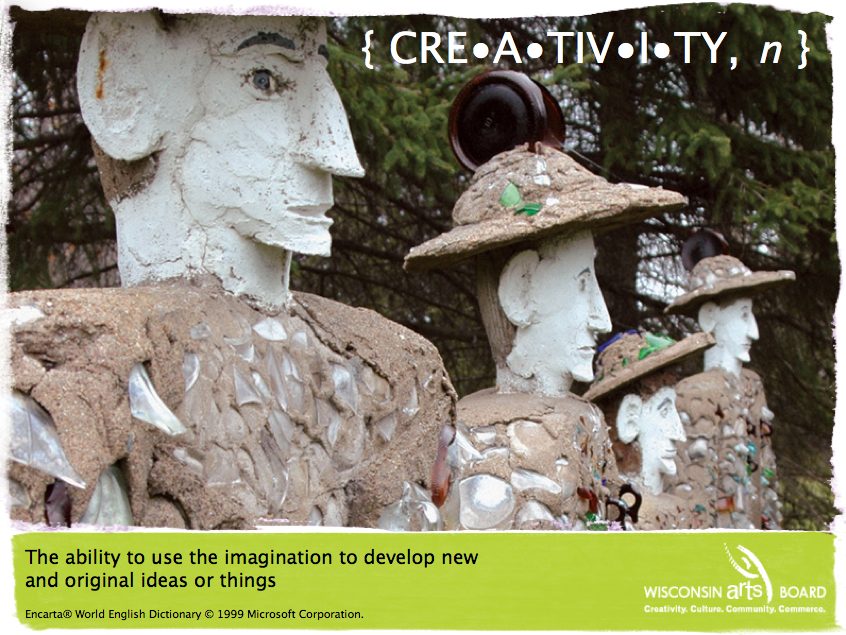 Recovery as a return to past development practices will not cut it in this new economy. Instead, recovery will come from economic reinvention. It demands a strategic focus on innovation and entrepreneurship, on ideas and on talent.
Recovery as a return to past development practices will not cut it in this new economy. Instead, recovery will come from economic reinvention. It demands a strategic focus on innovation and entrepreneurship, on ideas and on talent.
 In this new creative economy, the emphasis has shifted to the attraction, retention, and expansion of human talent and creativity. In fact, creativity is the ultimate renewable energy source to fuel economic growth. But we have to develop it, attract it, and hold on to it. Our communities must be magnets of opportunity for diverse talent. Our schools must provide the rich culture in which creativity can flourish.
In this new creative economy, the emphasis has shifted to the attraction, retention, and expansion of human talent and creativity. In fact, creativity is the ultimate renewable energy source to fuel economic growth. But we have to develop it, attract it, and hold on to it. Our communities must be magnets of opportunity for diverse talent. Our schools must provide the rich culture in which creativity can flourish.

So “What can the arts do to fuel our state’s economic recovery and growth?” The answer lies in the Wisconsin Arts Board positioning statement, which lays out the progression of our work: Creativity, Culture, Community, and Commerce.
 Creativity drives innovations in science, business, technology and even service industries. Entrepreneurs are problem-solvers, innovators by definition, and visionaries when at their best. Creativity can also be defined as the process of having original ideas that have value. That in itself is a highly desirable quality for any business and a major competitive advantage.
Creativity drives innovations in science, business, technology and even service industries. Entrepreneurs are problem-solvers, innovators by definition, and visionaries when at their best. Creativity can also be defined as the process of having original ideas that have value. That in itself is a highly desirable quality for any business and a major competitive advantage.
Developing the arts and creativity, especially in education programs is both a deliberate workforce development strategy and one that stimulates innovation and enables entrepreneurship.
 The Wisconsin Arts Board also serves as a resource for people of every cultural expression and heritage in Wisconsin.
The Wisconsin Arts Board also serves as a resource for people of every cultural expression and heritage in Wisconsin.
The arts at once express the singular cultural identities of communities and groups and underline their shared, universal dreams. Minority cultures find voice and recognition in the common culture through the arts. Rich cultural diversity defines Wisconsin and makes this a great state to call home and a great place to start or grow a business.
Creativity and culture build strong community, animate it and make it a magnetic force for that young and restless workforce we all want to attract and lock down. Businesses that thrive in this economy follow that effort.
Commerce, in urban and rural areas alike, national and international, must be innovative and competitive with a creative talent pool, expressing understanding and respect for distinct cultures, and ensuring a strong community base.
These four Cs, Creativity, Culture, Community, and Commerce, are a dynamic platform for that could continue to be the work of our Wisconsin Arts Board—a platform that informs economic development strategies for growth, along with educational programming. That is because arts education will be absolutely critical in preparing our children for success in this new creative economy.
In a fast-changing world where we are bombarded with more information than can be humanly processed, knowledge represents what can be known, while creativity is the capacity to manage the unknown. Together, the equation represents a competitive advantage, one that must be used to drive the smart allocation of resources in education.
No one disputes (except those trying to gut pubic education in Wisconsin) that every child needs to be highly literate in science and math today. In Wisconsin and across the country, there is a need for more workers who are proficient in the STEM studies—science, technology, engineering and math.
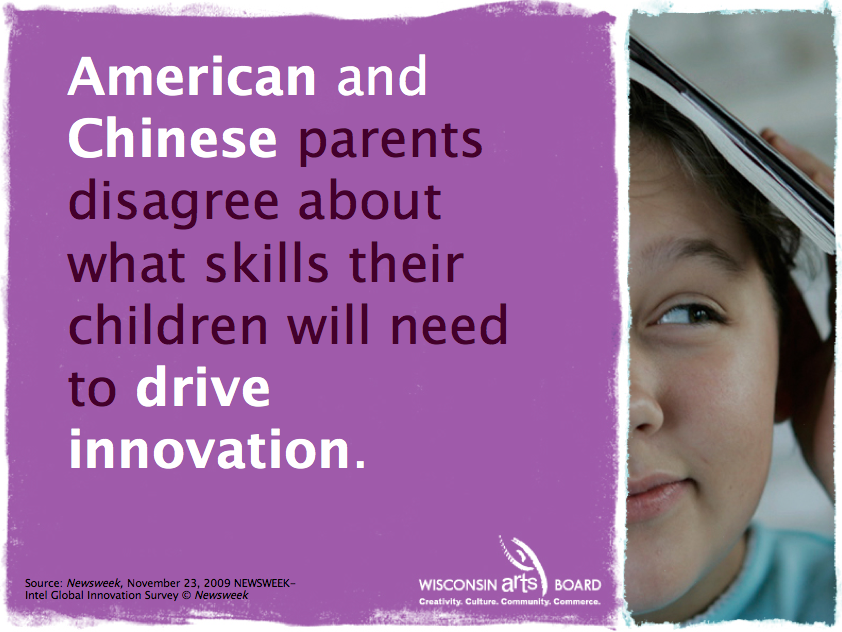 But to be truly competitive in our global economy, our children also need to be innovators and bold thinkers with entrepreneurial confidence. So how do we teach those skills?
But to be truly competitive in our global economy, our children also need to be innovators and bold thinkers with entrepreneurial confidence. So how do we teach those skills?
Not everyone agrees on what elements are necessary for nurturing innovative thinking and entrepreneurial confidence. In fact, a recent innovation survey conducted by Newsweek and Intel showed some striking differences between the U.S. and our stiffest global competitor, China.
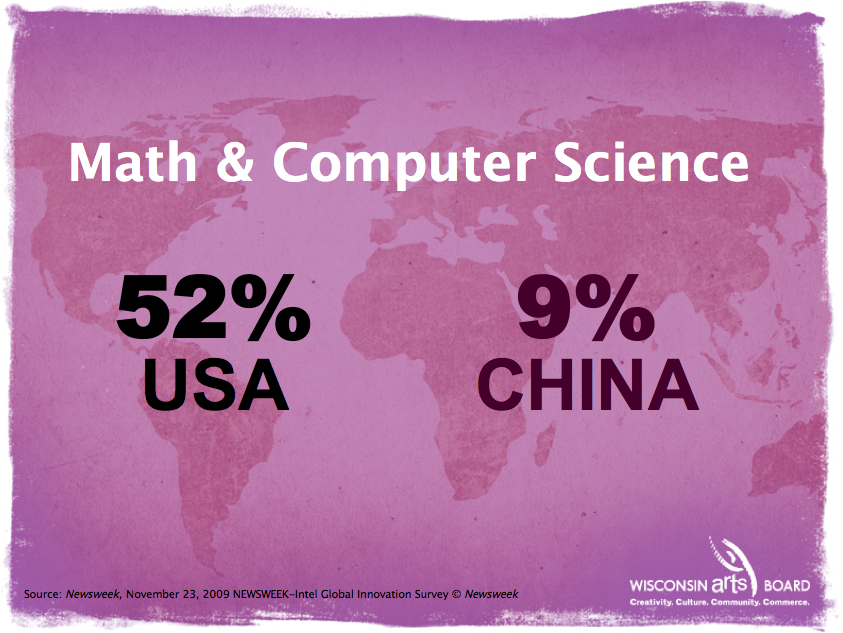 Americans are far more focused on improving the analytical skills that come with math and science education…
Americans are far more focused on improving the analytical skills that come with math and science education…
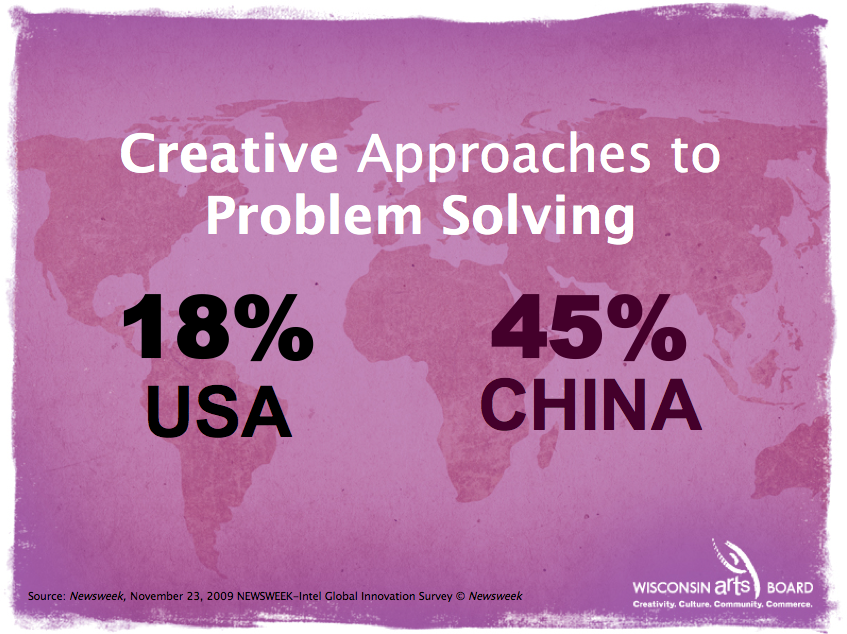
…while the Chinese are more concerned with developing creativity and problem-solving skills…
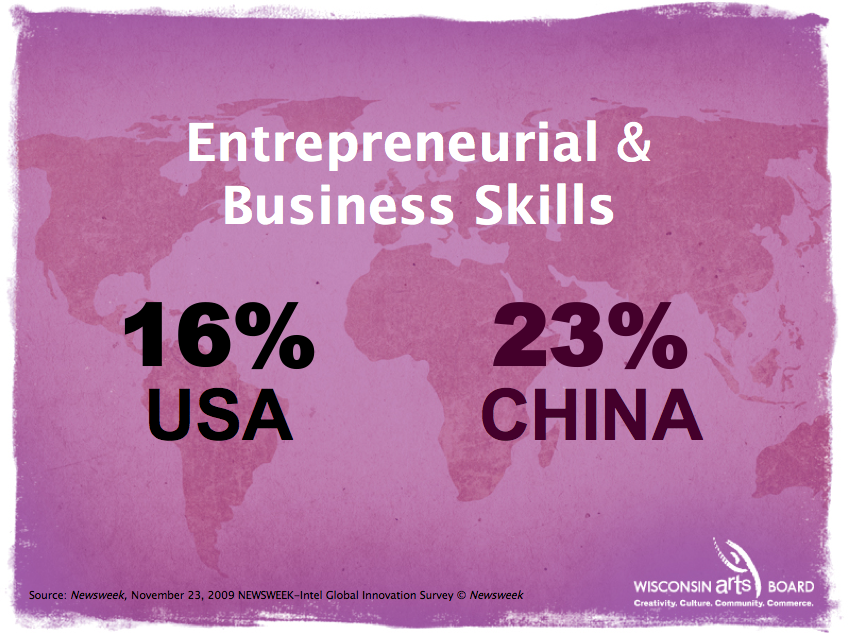
…and with improving entrepreneurial business skills…
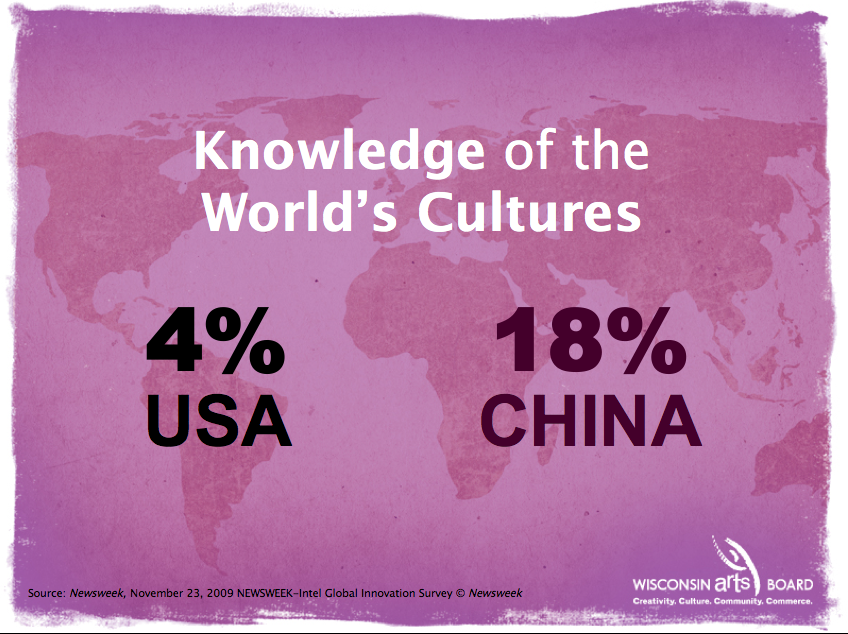
…and with enhancing their children’s understanding of cultures around the globe.
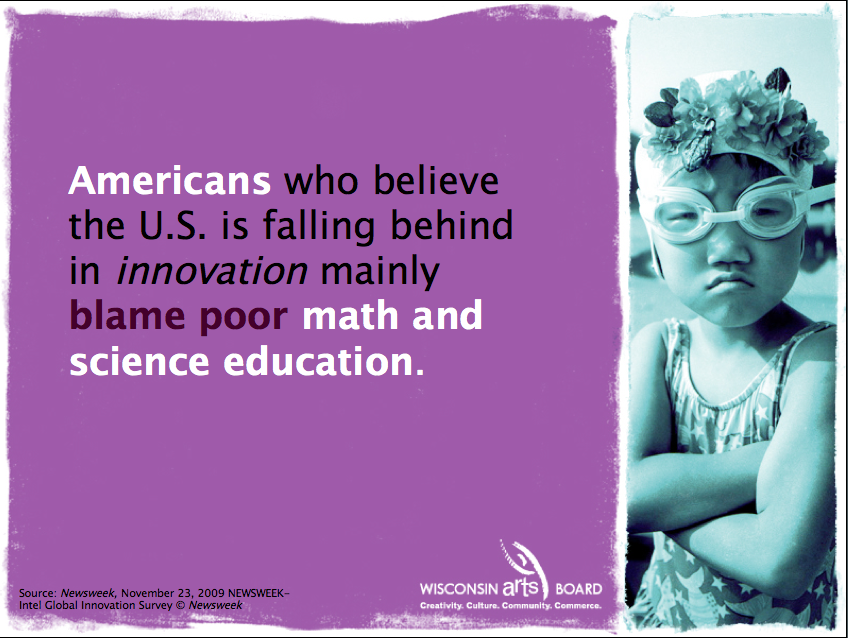
Our belief as a country is that the skill sets math and science provide are what drive innovation, when in reality, innovation is driven more so by creativity, by problem-solving abilities, and by entrepreneurial aptitudes—the very skills that the arts cultivate as advocated by your Wisconsin Arts Board.
So what should we be teaching in order to build a more innovative future?
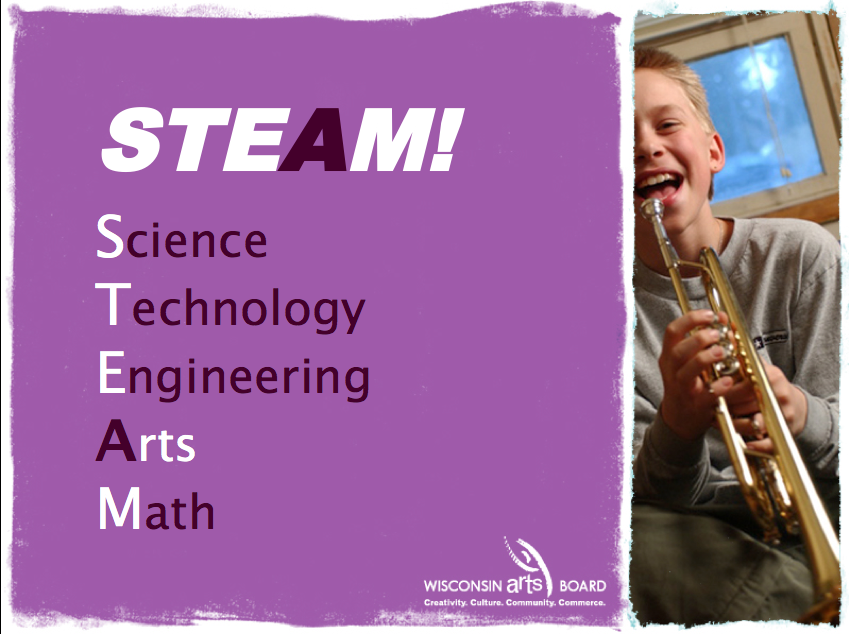 The Wisconsin Arts Board has insisted that we put the arts right in the middle, turning STEM into STEAM to power up our state’s economy. Math, science, computer technology and engineering turn high-level thinking into ideas with great value when fueled by creativity.
The Wisconsin Arts Board has insisted that we put the arts right in the middle, turning STEM into STEAM to power up our state’s economy. Math, science, computer technology and engineering turn high-level thinking into ideas with great value when fueled by creativity.

Your Wisconsin Arts Board has played a significant role in our state’s economic outlook—as trend predictors and consultants to regional economic organizations, informing better state investments in growth, and developing unprecedented public and private partnerships to ensure their value.
Given just how great an impact the arts can have on our state’s economic future and on the success of our children, the question left to ask: what’s this worth to us?
Other states are still investing in the arts and its economic impact. Hawaii invests $4.78 per citizen each year in the arts. Closer to home, Minnesota’s per-person state allocation to the arts is $5.80. Alabama kicks in 99 cents and Tennessee’s per capita is $1.35. Up until 2010 Wisconsin spent 43 cents per citizen annually in State Arts funding placing it near the bottom. Now Wisconsin will be investing 13.5 cents per-person if the proposed budget cuts go through. We will rank 49th in public funding for the arts.
Where should Wisconsin be in this lineup? What’s it worth to us to ensure the infrastructure of our arts and culture sector stays strong? To ensure those organizations and creative businesses enjoy conditions conducive to growth? To equip our children with the creative skills for success?
Wisconsin doesn’t have a great record of public support for the arts. 1992 was the last year in which the Wisconsin Arts Board’s budget was increased beyond obligatory salary raises. Even as Arts Board funding has effectively declined, the shift to a knowledge-based, creative economy has generated increased demand for the Board’s services and expertise, and for more grants to accommodate changing regional economies.
 The Wisconsin Arts Board has worked to stimulate growth and strengthen the impact of artists and arts organizations on regional economies, and expand community capacity for creativity, innovation and entrepreneurship.
The Wisconsin Arts Board has worked to stimulate growth and strengthen the impact of artists and arts organizations on regional economies, and expand community capacity for creativity, innovation and entrepreneurship.
The Wisconsin Arts Board has worked to advance development and innovative partnerships across the state, while catalyzing new ones. They have strengthen collaboration between public, nonprofit, and private sectors to attract and leverage increased investment in the arts throughout the state.
We had hoped, with a slight increase in resources, that the Wisconsin Arts Board would lead nationally groundbreaking work linking development of creativity in education to the solutions needed to build sustainable businesses, communities, and creative industries in our state. Instead we see decisions underway that will gut support for public art, art education and education in general and drive creative industries and creative thinkers from our state.
The challenge to the arts in Wisconsin is reflected on the national level with challenges to funding for the National Endowment for the Arts, the National Endowment for the Humanities, and the National Broadcasting System, among other progressive programs that influence our quality of life as Americans.
“Art Works” is The National Endowment for the Arts message evoking the plays, paintings, dances, films and other creations of artists.
It also describes the way art can transport, inspire, challenge and transform its audiences.
Art Works reminds us that making art is work—work that creates jobs and contributes to the economy with new tax revenues and livable communities.
Art Works describes the commitment of the Wisconsin Arts Board and the National Endowment for the Arts in their shared service to the state and nation. With proper public systems of support in place, art, artists and arts professionals work to enrich lives and livelihoods everywhere. Without this commitment this work will be much, much harder.
Finally, we should remember that the arts-in-education is absolutely critical in building tomorrow’s work force, in preparing our children for success in this creative economy. With the attacks on teachers and the cuts to education in the State our children will not have access to the teachers who have the time and resources they need to engage them in all the ways they deserve to be engaged in all forms of learning, including creative learning. Our children deserve better.
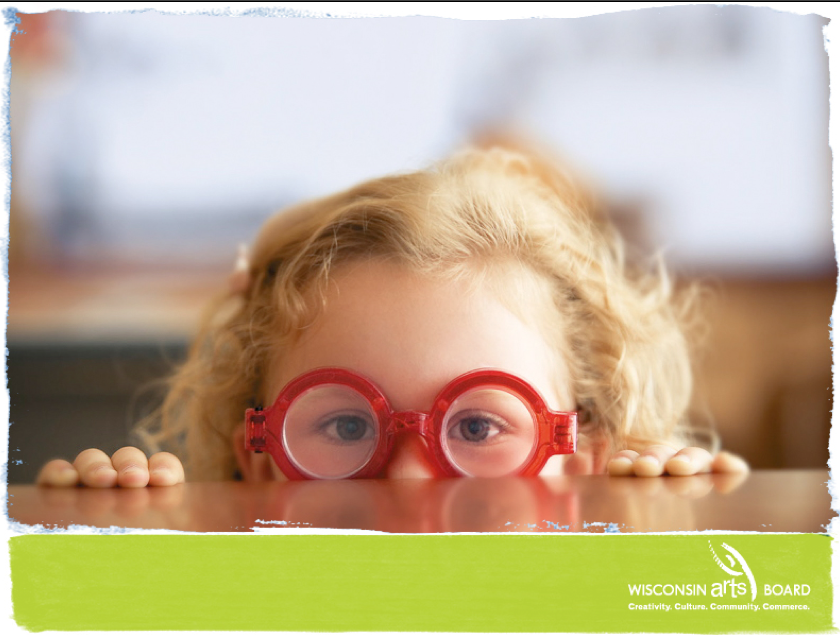 The budget and budget repair bill contain fiscal and non-fiscal proposals that reflect an ideology that does not appear to value the arts, education, or public service. Wisconsin’s citizens and children will suffer if this budget and related bills move forward. We deserve better. As we make decisions about the future of Wisconsin the elimination of the Wisconsin Arts Board does not serve the citizens of Wisconsin well.
The budget and budget repair bill contain fiscal and non-fiscal proposals that reflect an ideology that does not appear to value the arts, education, or public service. Wisconsin’s citizens and children will suffer if this budget and related bills move forward. We deserve better. As we make decisions about the future of Wisconsin the elimination of the Wisconsin Arts Board does not serve the citizens of Wisconsin well.
Portions of the above drew on a power point presentation designed by Wisconsin Arts Board member Paul Meinke, founder of Arketype Inc, in Green Bay, Wisconsin.

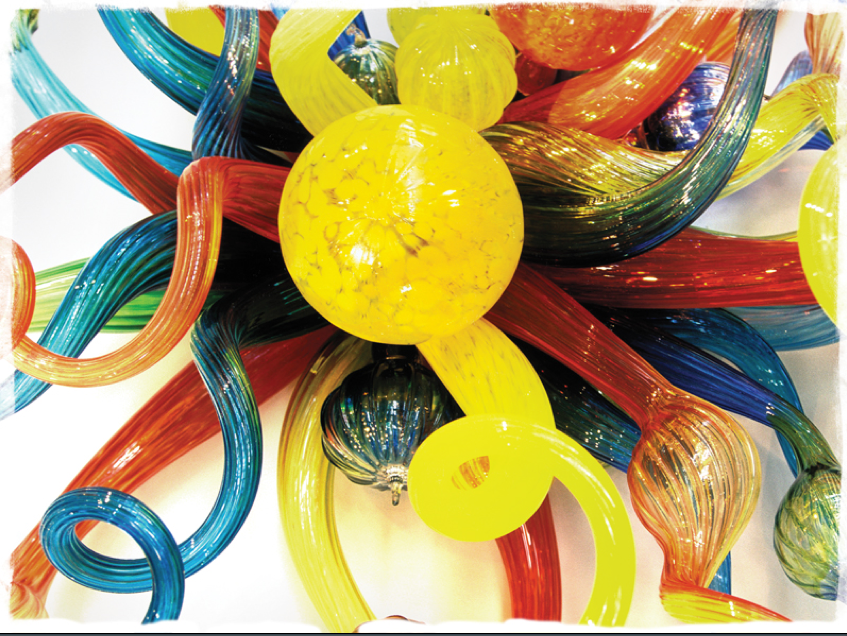

4 comments
Here is a good overview of exactly what is being cut: http://volumeone.org/blogs/1/post/2260/What_the_budget_repair_bill_means_for_Wiscosnin_arts
Helen,
Thank you for your eloquent statement that I’ll share with others who have been subjected to my anguished despair. I’m tying very hard to remain positive.
Janis
We will have to figure out with other artists, cultural workers and arts organizations how to preserve Wisconsin’s commitment to the arts and creative culture. We will may have to rebuild when the administration changes but I suspect that will be sooner rather than later.
For those Art Workers interested in being a visible presence at the rallies in Madison, there is an Art Workers March planned for March 12th at the capitol. We will gather at the Overture Center after the Farmer’s Tractorcade (I love Wisconsin) around 2:00 but before 3:00. There is a facebook page that you can go to for updates here:
http://www.facebook.com/group.php?gid=73295322449#!/pages/Arts-Workers-for-Wisconsin/156415884415735
If you would like to order a t-shirt to wear as a show of numbers, go here to give them an idea how many to order (you pay for it): http://www.facebook.com/group.php?gid=73295322449#!/notes/arts-workers-for-wisconsin/want-a-t-shirt-please-like-this-if-you-do/156427517747905
Your email is used for verification purposes only, it will never be shared. By submitting a comment you grant Helen R. Klebesadel a perpetual license to reproduce your words and name/web site in attribution. Inappropriate and irrelevant comments will be removed at an admin’s discretion.